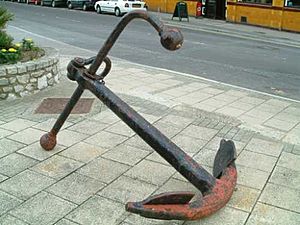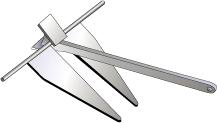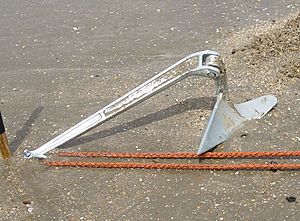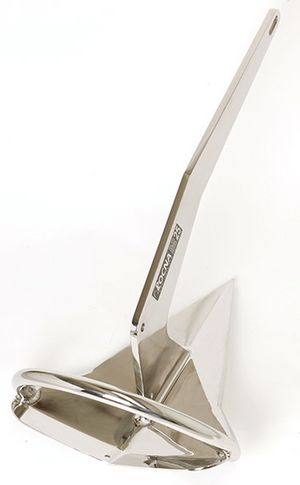Anchor facts for kids
Anchors are special tools used to stop boats from floating away. Most anchors today are made of metal. They are designed to dig into the ocean floor, also called the seabed, to hold a boat in place.
There are two main kinds of anchors: temporary and permanent. A permanent anchor is often called a mooring block. It is very heavy and not meant to be moved often. A temporary anchor is carried on a boat and can be dropped and pulled up easily. When people talk about anchors, they usually mean temporary ones.
Anchors work in two ways: by being very heavy or by their shape. For temporary anchors, their shape is very important. The design helps them grip the seabed. Anchors need to be strong enough to hold a boat against wind, water currents, and the up-and-down movement of waves.
Contents
History of Anchors
The very first anchors were just heavy rocks. Many rock anchors have been found from ancient times. Even today, some permanent moorings still use a large rock to hold boats.
A simple anchor design that uses two wooden arms and a rock for weight is still used sometimes. The sharp wooden arms help it dig into the seabed. The weight helps it stay put against normal water movement.
How Temporary Anchors Work
A modern temporary anchor usually has a main bar called the shank. This shank connects to a flat part called the fluke, which digs into the seabed. The crown is where the shank meets the fluke. At the top of the shank, there is a ring or shackle. This is where the rode connects. The rode is the chain, rope, or cable that joins the anchor to the boat.
Some older anchors have a stock. This is a bar that sticks out from the shank. It helps the anchor land in the right way on the seabed so the fluke can dig in. Anchors are sometimes called "stocked" or "stockless" depending on if they have this bar.
There are many different designs for temporary anchors.
Fisherman Anchor
The Fisherman anchor has a very old, traditional design. It hasn't changed much over time. This type of anchor is not as strong as many newer designs. It doesn't hold as well for its weight compared to other anchors.
Fluke Anchor
The Danforth is a very common type of fluke anchor. It has a stock near the crown and two large, flat flukes. The stock can turn, which helps the flukes point towards the seabed. It can hold a boat very well once it's set. However, it can be hard for it to set (dig into the seabed) by itself. It is a good choice for its weight.
Fluke anchors can have trouble digging into seabeds with lots of kelp or weed. They also struggle in very hard sand or clay. Once set, this anchor might come loose and not dig back in on its own.
Grapnel Anchor
The Grapnel anchor is another traditional design. It is simple to make. It looks like a simple hook. This anchor works well for rocky seabeds or reefs. However, it is not useful for most other types of seabeds.
Plow Anchor
The first CQR plow anchor was invented in 1933 in the United Kingdom. Many similar anchors are made today. Plow anchors used to be very popular with sailors and private boat owners. They work well in most seabeds, but not perfectly. A newer design called the Delta is even better.
Plow anchors often have a special weight in the tip of the fluke, called the toe. This helps them work correctly, but it also makes them heavy.
Bruce / Claw Anchor
The original Bruce anchor was created in the 1970s. It was designed to fix some problems with plow anchors. Many copies of this anchor are now made. This type of anchor is now called a "claw-type" anchor. Claw anchors can dig in quickly in some seabeds. However, they don't hold as well for their weight and can sometimes let go suddenly.
Modern Anchor Designs
Many new anchor designs have appeared in the last 20 years. These modern anchors are often made to be better than the older plow and claw types. Most are designed for smaller boats, not large ships.
- The Bügel anchor has a sharp fluke. This helps it dig into seabeds with weeds. It also has a roll-bar that helps the anchor turn to the correct angle when it lands on the seabed.
- The Bulwagga anchor has three flukes instead of two. It has performed well in tests by different groups.
- The Spade anchor has been popular since 1996 and works very well.
- The Rocna anchor has been made since 2004. Like the Bügel, it has a sharp toe and a roll-bar. This helps it set quickly in weed and grass. It has a large fluke area, which means it can hold a lot. The roll-bar helps it land at the right angle to dig in, even with a lighter tip. The Rocna anchor got the highest average holding power in tests done by SAIL magazine in 2006.
Anchor Holding Power
Many modern anchor designs are better than older ones. A chart from West Marine (a marine shop in America) in 2006 shows tests of different anchors. The anchors were tested in three different sandy seabeds. They were also tested at three different scopes, which are the angles at which the anchor line pulls.
Six of the seven best anchors in this test were "modern" designs. However, some modern anchors did not perform well at all. This shows that newer designs are not always better.
Permanent Anchor Designs
Permanent anchors are used when something needs to stay in one place for a very long time. They are used for things like Lightships, navigation buoys, and permanent moorings. These anchors must be strong enough to hold in all kinds of weather, even during the worst storms.
Deadweight Anchor
A deadweight anchor is simply a very heavy weight. It can be used when the bottom of the ocean is too hard for other types of anchors to dig in. It can be a very large rock or a heavy concrete block.
Mushroom or Pyramid Anchor
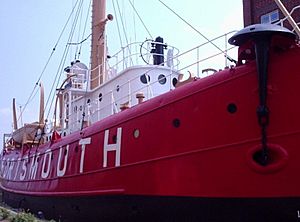
Mushroom and pyramid anchors work well where the seabed is soft. This type of anchor needs time to dig itself deep into the seabed. It can be smaller and lighter than a deadweight anchor. The mushroom anchor looks like a mushroom, and the pyramid anchor looks like a pyramid with its point facing down.
Modern Permanent Anchors
The sand screw is a modern permanent anchor. It must be screwed into the seabed before it is used. This type of anchor can be very light.
Images for kids
-
Stockless ship's anchor and chain on display
-
Anchor of Amoco Cadiz in Portsall, north-west Brittany, France
-
Holding ground in Akaroa Harbour
-
Statue of Peter the Great in Voronezh, Russia. He is leaning on an anchor, symbolic of his contributions to modernizing and expanding Russia's navy (1860)
-
A 1914 Russian poster depicting the Triple Entente of World War I, with Britannia's association with the sea symbolized by her holding a large anchor
See also
 In Spanish: Ancla para niños
In Spanish: Ancla para niños


